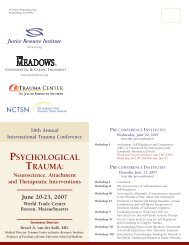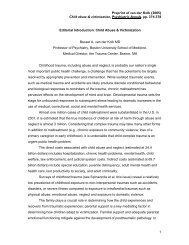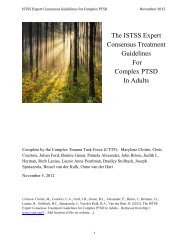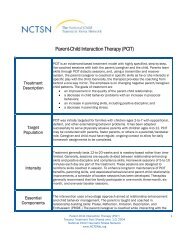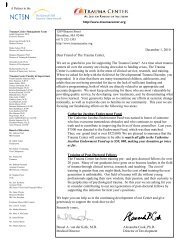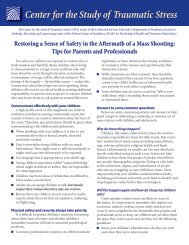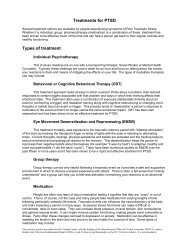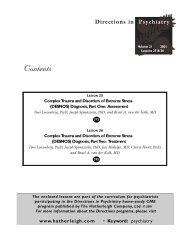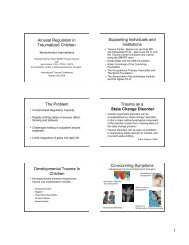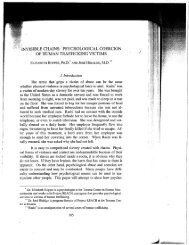4 CW360 o <strong>Trauma</strong>-Informed <strong>Child</strong> <strong>Welfare</strong> Practice • W<strong>in</strong>ter 2013What is <strong>Trauma</strong>tic Stress?Lucy Berl<strong>in</strong>er, MSWWhat is a <strong>Trauma</strong>?<strong>Trauma</strong>s are events <strong>in</strong>volv<strong>in</strong>g threat or danger.<strong>The</strong>y do not have to be actually violent.<strong>The</strong> perception that someth<strong>in</strong>g terriblecould happen can make the event traumatic.<strong>Trauma</strong>s may be directly experienced,witnessed or happen to a close loved one.<strong>The</strong>y <strong>in</strong>clude child abuse, rape, violent crime,witness<strong>in</strong>g DV or community violence,serious accidents or natural disasters, and theviolent or sudden death of a loved one. Notall bad experiences are traumas. Neglect, notbe<strong>in</strong>g loved, foster care, parental <strong>in</strong>carcerationand mental illness are adversities that can havenegative effects.<strong>The</strong> Prevalence of <strong>Trauma</strong>tic EventsExposure to trauma is very common.Accord<strong>in</strong>g to F<strong>in</strong>kelhor (F<strong>in</strong>kelhor et al,2009) each year about 60 % of childrenexperience at least one trauma. A subset,about 22%, has four or more different typesof traumas. <strong>Trauma</strong>s can range from the lessserious, be<strong>in</strong>g hit by a sibl<strong>in</strong>g occasionally,to the extremely serious such as be<strong>in</strong>g rapedor witness<strong>in</strong>g a parent murdered. <strong>Trauma</strong>exposure is almost universal among children<strong>in</strong> the child welfare system (CWS). Forexample, even though neglect comprises themajority of all CWS cases, many neglectedchildren have witnessed DV or communityviolence.What is Post-<strong>Trauma</strong>tic StressDisorder (PTSD) and How Does itDiffer from PTS?A m<strong>in</strong>ority of children will experiencepersist<strong>in</strong>g or worsen<strong>in</strong>g traumatic stress thatbecomes Post-<strong>Trauma</strong>tic Stress Disorder.PTSD and altered bra<strong>in</strong> structures and stressresponse systems. It is not clear whetherthese biological differences create <strong>in</strong>creasedsusceptibility to PTSD or are the biologicalexplanation of PTS (Neigh, Gillespie, &Nemeroff, 2009). Overall, research showsthat the accumulated burden of multipleF<strong>in</strong>d<strong>in</strong>g out that a child has been exposed to trauma creates theopportunity for all <strong>in</strong>volved <strong>in</strong> child serv<strong>in</strong>g sett<strong>in</strong>gs to actively contributeto the child’s recovery from the impact.OverviewWhat is Posttraumatic Stress(PTS) and How Does it Differ from<strong>Trauma</strong>?Be<strong>in</strong>g exposed to a trauma is almost alwaysupsett<strong>in</strong>g. <strong>Trauma</strong>-specific reactions are calledposttraumatic stress (PTS). PTS is unwantedand upsett<strong>in</strong>g memories or dreams of thetrauma and <strong>in</strong>tense emotional and physicalreactions when th<strong>in</strong>k<strong>in</strong>g about or be<strong>in</strong>grem<strong>in</strong>ded of the traumas. Avoidance cop<strong>in</strong>gstrategies decrease the negative emotionalstates when th<strong>in</strong>k<strong>in</strong>g about the traumas. PTSalso <strong>in</strong>cludes heightened physical arousalresponses such as jump<strong>in</strong>ess, irritability,difficulty concentrat<strong>in</strong>g, and trouble sleep<strong>in</strong>g.<strong>Trauma</strong>tic stress is a normal reaction to a verybad experience; most children exposed totraumas have at least some symptoms. PTSis not the only consequence of exposure to atrauma observed <strong>in</strong> children. Symptoms ofgeneral anxiety, depression, and behavioraldisruption are also seen follow<strong>in</strong>g traumas.Some children do not show distress follow<strong>in</strong>gtraumas, and for most the PTS will subsideover time without treatment.Occasionally, children develop PTSD after aperiod of appear<strong>in</strong>g to be f<strong>in</strong>e. To make thediagnosis, a qualified professional conductsa systematic assessment to f<strong>in</strong>d out if thesymptoms required by the Diagnostic andStatistical Manual (DSM) are present.<strong>The</strong> diagnosis requires a certa<strong>in</strong> number ofsymptoms of <strong>in</strong>trusive memories, avoidanceor numb<strong>in</strong>g reactions, and hyperarousalsymptoms and that symptoms have persistedfor at least a month and <strong>in</strong>terfere withfunction<strong>in</strong>g. Just be<strong>in</strong>g exposed to a traumaor be<strong>in</strong>g upset about the trauma does notmean PTSD.Predictors of PTSD <strong>in</strong> <strong>Child</strong>renCerta<strong>in</strong> factors place children at greater riskfor develop<strong>in</strong>g PTSD. <strong>The</strong> ma<strong>in</strong> predictorsare more serious traumas, perception of lifethreat, prior traumas or psychiatric problems,and be<strong>in</strong>g female. A negative reactionfrom others also is associated with PTSD.Recent biological research demonstrates anassociation between child abuse and neglect,and different bad experiences (traumas andadversities) is more important than thespecific type of trauma <strong>in</strong> predict<strong>in</strong>g PTSD.Immediate Responses to <strong>Trauma</strong>We now have strategies to help children whohave experienced trauma and have PTS.Psychological First Aid (PFA) (National<strong>Child</strong> <strong>Trauma</strong>tic Stress Network, www.nctsn.org) is an approach for acute situationswhere the trauma has just occurred. Itwas orig<strong>in</strong>ally designed for disasters, thepsychological field response accompany<strong>in</strong>gother rescue efforts. <strong>The</strong> ma<strong>in</strong> <strong>in</strong>gredientsare focus<strong>in</strong>g on here and now concerns,provid<strong>in</strong>g psychoeducational <strong>in</strong>formationand normalization, support, re<strong>in</strong>forcement ofcop<strong>in</strong>g skills, and, when needed, facilitat<strong>in</strong>gaccess to ongo<strong>in</strong>g services. With children,engag<strong>in</strong>g caregivers is key. PFA usually<strong>in</strong>volves one or two sessions. This type ofapproach can be used <strong>in</strong> emergency rooms,dur<strong>in</strong>g child welfare <strong>in</strong>vestigations, <strong>in</strong> <strong>Child</strong>Advocacy <strong>Center</strong>s, and DV shelters. A
CW360 o <strong>Trauma</strong>-Informed <strong>Child</strong> <strong>Welfare</strong> Practice • W<strong>in</strong>ter 2013 5slightly more <strong>in</strong>tensive approach is the <strong>Child</strong>and Family <strong>Trauma</strong>tic Stress Intervention(Berkowitz, Stover, & Marans, 2011). Thisfour session <strong>in</strong>tervention is delivered with<strong>in</strong>a month of the traumatic event and cansignificantly lower PTS and PTSD.Screen<strong>in</strong>g for PTS and PTSDRout<strong>in</strong>e screen<strong>in</strong>g is the best way to identifychildren who have high levels of PTS orPTSD and would benefit by trauma-specifictherapy. It is most important <strong>in</strong> childserv<strong>in</strong>g sett<strong>in</strong>gs where children have highrates of exposure and are most likely to besignificantly affected by their experiences,such as child welfare, mental health andjuvenile justice. Experience shows thatchildren are not distressed at be<strong>in</strong>g askedabout traumas and are more likely to reportwhen asked. <strong>The</strong>re are checklists for screen<strong>in</strong>gfor a trauma history (see the article byConradi <strong>in</strong> this publication for more detailed<strong>in</strong>formation on screen<strong>in</strong>g). Screen<strong>in</strong>g is thefirst step to <strong>in</strong>sure that children are assessedfor mental health needs and to facilitateaccess to evidence-based therapy such as<strong>Trauma</strong>-Focused CBT (Cohen, Mannar<strong>in</strong>,& Debl<strong>in</strong>ger, 2006). Professionals operat<strong>in</strong>gwith<strong>in</strong> the best practice multidiscipl<strong>in</strong>arymodel or a <strong>Child</strong> Advocacy <strong>Center</strong> are wellequipped to seamlessly facilitate access totrauma-specific assessment and therapy.Provid<strong>in</strong>g SupportSimply ask<strong>in</strong>g about abuse and trauma is notsufficient s<strong>in</strong>ce the children already knowwhat they have experienced. <strong>The</strong> key is tolearn about children’s reactions and respond<strong>in</strong> a supportive way. Professionals and otherssuch as foster parents can provide noncl<strong>in</strong>ical<strong>in</strong>terventions that are immediatelyhelpful, such as normaliz<strong>in</strong>g PTS reactions,offer<strong>in</strong>g support and giv<strong>in</strong>g comfort. Evenchildren who do not have significant PTSmay have been affected by their experiencesand appreciate acknowledgement that thetrauma was bad, frighten<strong>in</strong>g or wrong. CPS<strong>in</strong>vestigators or forensic <strong>in</strong>terviewers may berequired to take care <strong>in</strong> the degree to whichthey validate children’s reports of abuse, butthey can still express appreciation and offersupport.PTS is a common reaction to exposureto trauma. F<strong>in</strong>d<strong>in</strong>g out that a child has beenexposed to trauma creates the opportunityfor all <strong>in</strong>volved <strong>in</strong> child serv<strong>in</strong>g sett<strong>in</strong>gs toactively contribute to the child’s recoveryfrom the impact. Simple steps such asacknowledgement, normaliz<strong>in</strong>g reactions,and provid<strong>in</strong>g support can reduce stress andpotentially avert the development of longertermconsequences. It is also the platform forfacilitat<strong>in</strong>g access to assessment and evidencebasedtrauma-specific treatment whennecessary. <strong>The</strong> key to mak<strong>in</strong>g a differenceis not avoid<strong>in</strong>g the trauma but rathercommunicat<strong>in</strong>g directly about the trauma andmak<strong>in</strong>g sure there is access to needed care.Lucy Berl<strong>in</strong>er, MSW is Director ofHarborview <strong>Center</strong> for Sexual Assaultand <strong>Trauma</strong>tic Stress, University ofWash<strong>in</strong>gton at Harborview Medical<strong>Center</strong>. She can be reached at lucyb@u.wash<strong>in</strong>gton.edu.OverviewEmail us at <strong>in</strong>fo@childwelfare.gov orcall toll-free at 800.394.3366Stay connected to child welfare <strong>in</strong>formation and resourcesFrom child abuse and neglect to out-of-home careand adoption, <strong>Child</strong> <strong>Welfare</strong> Information Gatewayis your connection to laws and policies, research,tra<strong>in</strong><strong>in</strong>g, programs, statistics, and much more!Go to www.childwelfare.gov:- Sign up for FREE subscriptions- Order publications onl<strong>in</strong>e- Chat live with our Information SpecialistsUse your smartphone toaccess the Gateway website.




